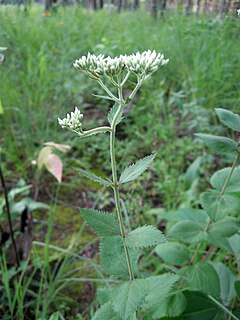
Galaxy Express 999 is a Japanese manga series. It is written and illustrated by Leiji Matsumoto, later adapted into a number of anime films and television series. It is set in a spacefaring, high-tech future in which humans have learned how to transfer their minds and emotions with perfect fidelity into mechanical bodies, thus achieving practical immortality.
Malea pilosa is a species of flowering plant in the family Ericaceae. It is the only species in the genus Malea, and is native to Mexico.

Prometheum is a genus of plants in the family Crassulaceae.

Symphyotrichum ericoides, known as white heath aster, frost aster, or heath aster, is a species of flowering plant in the family Asteraceae native to much of central and eastern North America. It has been introduced to parts of Europe and western Asia.
Septobasidium pilosum is a plant pathogen, one of a number of fungi in the genus Septobasidium responsible for the disease of tea plants known commonly as "velvet blight".

Eupatorium rotundifolium, commonly called roundleaf thoroughwort, is a North American species of plant in the family Asteraceae. It native to the eastern and central United States, in all the coastal states from Maine to Texas, and inland as far as Missouri and the Ohio Valley. It is found in low, moist habitats such as wet savannas and bogs.

Symphyotrichum pilosum, commonly called hairy white oldfield aster or frost aster, is a flowering plant in the family Asteraceae native to central and eastern North America. It is a perennial, herbaceous plant that may reach 20 to 120 centimeters tall. Its flowers have white ray florets and yellow disk florets.

Pycnanthemum is a genus of herbaceous plants in the mint family (Lamiaceae). Species in this genus are often referred to as "mountain mints" and they often have a minty or thyme-like aroma when crushed. All species of Pycnanthemum are native to the United States and Canada. The center of diversity for the genus is North Carolina with 13 of the 20 species having been collected therein. Nineteen of the 20 species of Pycnanthemum occur in the Eastern US and Canada, and one disjunct species occurs in California and Oregon.

Alexiidae is a family of beetles. It contains a single genus, Sphaerosoma, formerly included within the family Cerylonidae, with around 50 species which are native to the western Palearctic. Species of Sphaerosoma are very small, around 1 to 2 mm in length rounded beetles with clubbed antennae. They are fungivores, having been observed feeding on mushrooms, and have been also been found in leaf litter and on decaying bark.
Canarium pilosum is a tree in the family Burseraceae. The specific epithet pilosum is from the Latin meaning "hairy", referring to the soft hairs of the twigs and leaves.
Canarium pilosum subsp. borneensis is a subspecies of Canarium pilosum. It is a tree in the family Burseraceae. The subspecies is named for Borneo.

Galium pilosum, the hairy bedstraw, is a species of plants in the Rubiaceae. It is native to the southern and eastern United States and Canada from Texas to Florida north to Kansas, Michigan, Ontario, Quebec and New Hampshire. There are also isolated populations in Arizona, New Mexico, Colorado and Hispaniola. The plant is classified as a noxious weed in New York, Pennsylvania, Massachusetts and Connecticut.
Eupatorium pilosum, common name rough boneset, is a rare North American species of plant in the family Asteraceae. It is native to the eastern and south-central United States, found in every coastal state from Massachusetts to Texas, and as far inland as Kentucky.

Acer pilosum is an Asian species of maple. It has been found only in north-central China.

Amphilophium is a genus of flowering plants in the family Bignoniaceae, native to South America. Amphilophium crucigerum has escaped from cultivation elsewhere, and has become an invasive weed in Australia.
Lasioglossum pilosum is a species of sweat bees in the family Halictidae. The species is a generalist and known to pollinate flowers as well as commercial fruits like apples.sometimes known to cause slightly irritating sting mild in comparison to most other stinging bee species

Geranium solanderi is a species of plant in the family Geraniaceae. It is native to Australia, and to New Zealand.

Symphyotrichum kentuckiense is a species of flowering plant in the family Asteraceae commonly known as Price's aster, Miss Price's aster, Sadie's aster, lavender oldfield aster, or Kentucky aster. It is a perennial, herbaceous plant endemic to the southeastern United States, specifically to broken limestone cedar glades and roadsides in Alabama, Georgia, Kentucky, and Tennessee. It blooms from August through October, reaches heights between 30 and 100 centimeters, and has green to reddish-brown stems. It is a hairless plant with blue to blue-violet ray florets.

Rosularia aizoon is a succulent that forms rosettes of hairy, pale green to blue-green leaves. It is hardy down to zone 7a and blooms in summer. The plant was first described as Prometheun aizoon by Eduard Fenzl then transferred to genus Rosularia by Alwin Berger in 1930.

Myrmecopterula moniliformis is a species of fungus in the family Pterulaceae and is the type species of the genus Myrmecopterula. It is associated with fungi cultivating ants of the genus Apterostigma.














